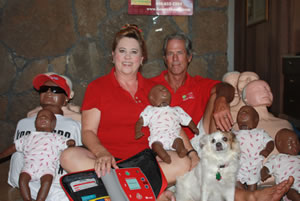Learning To Save A Life
Cheryl Ann and Stephen FarrellHearts for Kaua‘i
How did you get started in this business and how long has it been going? Cheryl Ann: I was the regional director of the American Heart Association (AHA) here on Kaua’i until 2008 when they closed the office because of budget constraints. At the time, I used to get calls almost daily from folks looking for where to get certified. The AHA doesn’t provide certification as an association (i.e., like the Red Cross does) but rather relies on third-party “vendors” to provide that service. On Kaua’i, it seemed you had to know someone personally to get a class. A lot of the firefighters, for example, are instructors, but again you’d have to know whom to call. So, when the office closed, I talked with Dave Walker (a retired firefighter, AHA faculty trainer, and my chairman of the board of directors for Kaua’i AHA) and along with Kaua’i Veterans Memorial Hospital, we were able to get certified as instructors. We officially started the business in January 2010 and we are in our third year.
Where are you from originally and what role does that play in your business? I am originally from Colorado, born and raised. I lived in Los Angeles for 15 years before moving to Kaua’i. I don’t know how that plays a role in my business other than having had experience running a business before. I’ve owned both an auto brokerage and dealership at one time, and owned and operated a small boutique advertising agency.
What is your specialty and who can benefit from it? Besides offering AHA certification (which is preferred in the health care industry), we are one of only a few instructors who offer the AHA e-Learning access. E-Learning is an interactive, online-based course instruction. After completing the online portion, the student meets with us, sometimes oneon-one, to practice the skills and successfully demonstrate skill proficiency for CPR and AED use. We offer community classes occasionally, but we do most of our business one customer/student at a time so people don’t have to wait for a class. Many businesses are required to have a certain number of employees certified in CPR for insurance requirements. We also offer classes at company locations and can customize that training with online and face to face.
What sets your business apart? The ability to choose to take a class online or in a group setting and the opportunity to complete certification in the learning mode that best suits the individual.
Why do you do what you do? To teach people to save lives. After working for the AHA, I realized how important CPR is to saving a life. The training can make people more confident and able to react and help in an emergency situation.
What motivates you to get up and go to work every day? To pay for gas in my car! I think I may be addicted to “busy.” I have a lot of things I do and CPR training is just one of them. I love the relationships that I’ve developed as the business builds.
And with all the work I do in volunteering, somehow it comes full circle.
Do you have a business motto or philosophy? Learn CPR, save a life.
What is the most challenging aspect of your business? Finding locations to do skills checks. Because we do so many one-onone sessions with individuals, finding a free location is not always easy. I sometimes go to the student’s home, sometimes they come to my home. Sometimes we conduct skills at Nursefinders (Bayada) when the student is a potential employee of theirs. I also teach at KCC ,and my office is actually in the nursing trailer. So occasionally I’ll conduct a skills check there. So, scheduling with someone, finding a location, and trying to make it convenient for both me and the student can be a challenge.
What is your business plan for the future? We plan to launch a new training element this month to include first aid and CPR training for pets. In fact, recently there was a story in the news that one of the competitors in the Alaska Iditarod had one of his dogs collapse and stop breathing. He performed mouth-to-snout breaths and CPR compressions and saved his dog’s life.
If you weren’t doing this, what would you be doing? Oh, I could easily stay busy. Not only do I teach for the business education department at KCC, but I also teach marketing at both Hawaii Pacific University and for Colorado State University. At CSU I’m also a faculty trainer and mentor, and I am part of the curriculum-writing team. I also am on the board for the Kaua’i March of Dimes and was the event coordinator the past three years. I am currently too busy to continue to take that on in its entirety. I’m also on the Worksite Wellness Task Force for Get Fit Kaua’i, and the silent auction coordinator annually for Koloa Plantation Days. Most recently, I joined the PR and membership committee for the Kaua’i Chamber of Commerce. So, if I weren’t also training people in CPR, I’d find something else to do – maybe professional photography again. I spent some time in California as a professional photographer after finishing a program in photo school.
Where can people learn more? On our website, hearts4kauai.com, via phone, 652-1284, or email: hearts4kauai@gmail.com.




